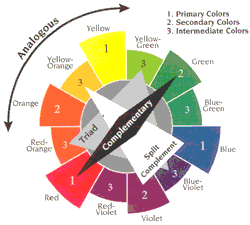|
Color Tips
 What is Paint?
What is Paint?
Paint is composed of three main elements:
Pigment gives it color and hides what is underneath.
Binder sticks the pigment to the surface being painted.
Carrier keeps the pigment and binder in liquid form, so they can be brushed on.
When paint dries, the carrier evaporates. The quality of these ingredients is crucial: the better the quality, the easier the paint will brush on and the longer the paint job will last.
Oil vs. Latex
Most paint falls into one of these two categories. Each has its pros and cons. Oil, or solvent-based paint, has a smooth, rich appearance that has made it a decorator's classic, but it yellows over time and is a major source of pollution.
Water-based paints, such as latex or acrylic, produce fewer fumes and safer for the environment, but dry so quickly that brush or roller marks can be visible.
Paint types:
High gloss:The shiniest paint, it imparts a stylish lacquered look and is durable and easy to wash. But use it only on pristine surfaces; the higher the gloss, the more it reflects imperfections. Apply on kitchen and bathroom walls, furniture, and trim.
Semi gloss:Easier to clean than flat paint. Use on busy spots, such as hallways, kid's rooms, and doors.
Eggshell:Closer to flat, this paint resists stains better and has a lustrous look. This is a good choice for playrooms, halls, bathrooms, and less shiny trim.
Pearl / Satin / Silk: Between Flat and Eggshell. Recommended for any type of rooms and hallways. Washable and you can make touch up. Some paint store may say it is between Eggshell and Semi gloss. It doesn't look glossy as much is eggshell and semi gloss paint.
Flat / Matte Enamel:The most forgiving paint for surfaces with flaws. Because this paint cannot be cleaned, keep an extra can on hand for touch-ups. Looks great on walls and Ceilings.
|
Here are some information about lighter and darker color.
How Color Affects Space?
You can use color to alter the apparent proportions of a room.
The examples on this page demonstrate that, for many people, dark colors make surface appear closer, while light colors make surfaces appear farther away.
Use contrasting colors (those that are far apart on the color wheel) to make a space appear smaller than it is. Use colors with little contrast (those that are closer together on the color wheel) when you want to make a space appear larger that it is.
Do these effects work for you? (They don't work for everyone.) If they do, you can use color to change the perceived dimensions of your rooms without actually moving walls or ceilings.
|

Dark Walls make a room seem smaller. |

A Dark Ceiling seems lower. Bring the ceiling color down the wall to enhance the effect of coziness. |

Reference Room |

Light Walls make a room seem larger. |

A White Ceiling seems higher and makes the room feel larger and airier. |

A Light Ceiling and dark walls make a room appear taller and narrower. |

Light Side Walls and dark end walls may make a long hall seem shorter. |

A Dark Ceiling and light walls may make a room appear shorter and wider. |

Dark Side Walls and a light end wall may make a hall seem longer, but some say the effect is the opposite. |
|
What color will look good here?
We are getting this kind of question over and over from our customers. That's why we decided to give you some information before you choose your color.
We can't tell you which color will look good, because everyone likes different colors and everyones taste is different. Maybe something we think will look good might not look good to you. Even the most famous designer can't tell you, which color you would like and enjoy. They can tell you which color look good to them. Please donít forget youíre the only one know which colors you like and enjoy.
But if you let as know the colors you like and enjoy, when you see them. We can suggest which color goes with your home or furniture and let you know which ones are complements each other and show you different shades of that color to help you on your color choosing decision.
|
 |
Analogous
One of the most acceptable and popular color combinations, and analogous color harmony technically includes one primary or secondary color with adjacent colors on the color wheel which form a 90&186; angle.
Complementary
A complementary color harmony is a combination of any two colors which lie directly across from each other on the color wheel.
Triad
A color triad is achieved by using any three colors equidistant on the color wheel.
Split Complement
A split complement is formed by combining a hue on one side of the color wheel with the color on each side of its direct complement.
|
Back to top |